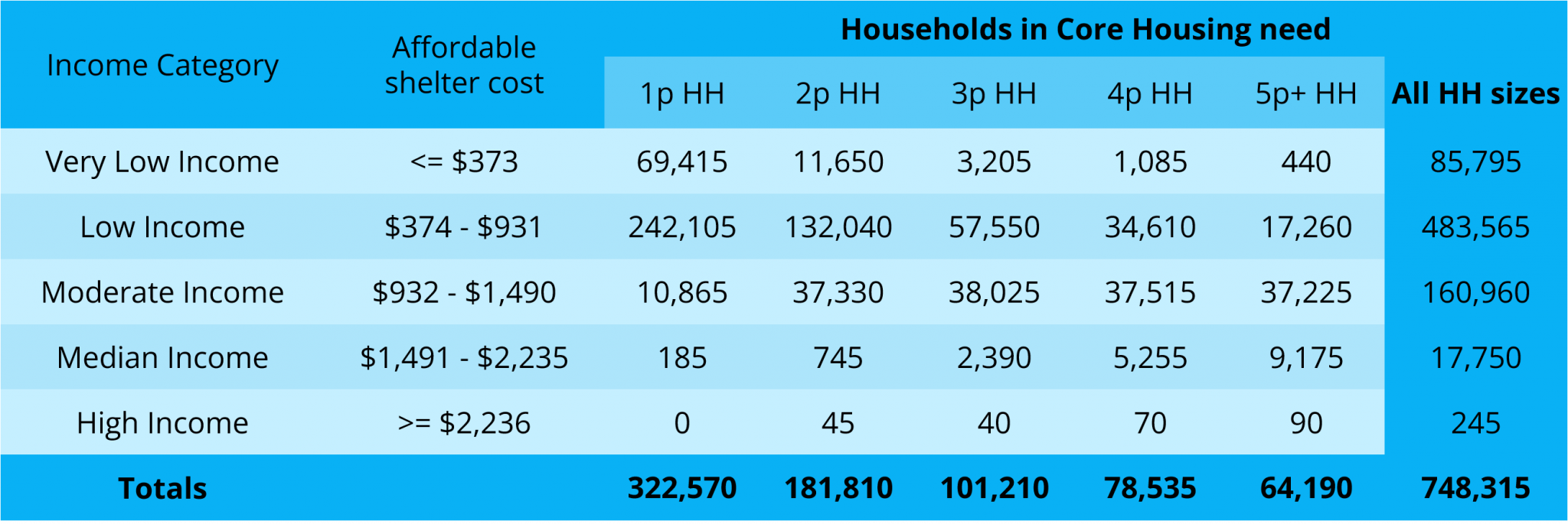View our full submission here.
View the accompanying slides here.
The HART Housing Need analysis (Figure 1) shows huge affordable housing deficits in Ontario: 750,000 households paying more than 30% of their pre-tax income on rent, being overcrowded and/or living in substandard homes. This figure excludes the needs of 8-10,000 people who are homeless at any given point in Ontario, 907,000 tertiary students (a large proportion of whom are studying in a different city from their families), people in rooming houses, long-term care and other congregate housing, and Indigenous people on reserve.
Based on this data, we support both greatly expanded non-profit and market supply of affordable and accessible housing, particularly housing that is well-located in relation to jobs, transit and services. This excludes net loss of affordable housing and the impacts of population growth and change. A 1.5 million new home target by 2031 is necessary, especially when the impact of households ‘driving until they qualify’ is included.
We would also recommend municipal sub-targets based on affordable housing deficits in Ontario, including a sub-target of 20% of all new housing being social and supportive housing (in order to address homelessness and core housing need) and 80% of all new housing being affordable (either in monthly rent or mortgage carrying costs assuming a 20% down-payment) to households earning 120% or less of area median household income (AMHI), with perpetual affordability ensured through rent controls or restrictive covenants lasting 99 years.
We have the following comments on the More Homes Built Faster Act.

Figure 1. Core housing need deficit, Ontario 2016 (source: HART, based on 2016 census)
CITY OF TORONTO ACT
Residential Rental Properties
The proposed changes would establish authority for the Minister of Municipal Affairs and Housing to make regulations imposing limits and conditions on the powers of the City to prohibit and regulate the demolition and conversion of residential rental properties under section 111 of the City of Toronto Act, 2006.
HART comment: This would have a disastrous impact on net affordable housing. Canadians lost 15 homes renting at $750 or less for every one new affordable home created at that price point between 2011 and 2016. Most of this net loss was due to demolition and renovation of residential rental properties. There is absolutely no reason why intensification on well-located properties should entail evictions without compensation, especially if new areas are opened up for zoning change (see below).
Site Plan Control
Complementary changes reflecting the site plan control changes proposed in the Planning Act are also proposed to the site plan control provisions in section 114 of the City of Toronto Act, 2006.
HART comment: Overly restrictive design considerations have added to costs and delays in housing provision. While we agree with this provision, accessibility and GHG targets are complementary to the legal requirement to work towards adequate housing and should not be eliminated.
CONSERVATION AUTHORITIES ACT
Subsection 8(3) would amend clause 28.0.1 (6) (a) of the Act to limit the factors that must be considered when making permitting decisions where a zoning order has been made authorizing a development project. The references to “conservation of land” and “pollution” would be replaced with “unstable soil and bedrock”.
HART comment: There are enough sites to increase well-located housing in existing urban and suburban areas, especially if there were provincially compelled zoning changes (see below). Residential sprawl into conservation areas has huge environmental, social and economic costs and should be avoided.
DEVELOPMENT CHARGES ACT
Exemptions for Additional Residential Units
Existing development charge exemptions for second residential units would be amended such that second and third residential units in existing or new detached, semi-detached homes and rowhouses would be exempt from development charges with no restrictions. Similarly, a second residential unit in a detached-house, semi-detached house or rowhouse and one residential unit in an ancillary structure would also be exempt from development charges.
HART comment: From a well-located affordable housing perspective, this is a positive change.
Exemptions for Affordable and Attainable Housing
The proposed changes would provide a development charge exemption for the development of affordable housing units. Affordable housing units would be rental units in which the rent is no greater than 80 per cent of the average market rent and ownership units in which the price is no greater than 80 per cent of the average purchase price. A bulletin, published by the Minister of Municipal Affairs and Housing, would set out the average market rent and average purchase price for the year to determine eligibility of the unit for the proposed development charge exemption. The developer would need to enter into an agreement with the municipality, which may be registered on title, that requires the unit to remain affordable for a period of 25 years.
Development charge exemptions would also be provided for attainable housing units. An attainable housing unit would be an ownership housing unit that is developed as part of a prescribed development and that meets any other criteria that may be prescribed through regulation by the Lieutenant Governor in Council (LGIC).
HART comment: If the goal is to provide the right supply, defining “affordable housing” by “proportion of market costs” rather than “housing costs in relation to household income” makes no sense. Market-based affordability programs have failed to provide genuinely affordable housing for low income households most at risk of homelessness. We would be in favour of this provision if and only if it applied to affordable housing for low to moderate income households earning less than 80% of area median household income (that is, a housing cost – whether rental or ownership – of no more than 30% of household income). The affordability covenant should be for no less than 99 years or in perpetuity. This is no less true for attainable housing i.e. rent to own.
Discounts for Rental Housing
The proposed changes would require a discount on development charges imposed on purpose- built rental units as follows: 15% for a 1-bedroom unit or smaller; 20% for a 2-bedroom unit; and 25% for a 3-bedroom unit or larger.
HART comment: Again, we would be in favour of these changes if and only if it covered purpose-built rental units that were affordable to average income households earning 120% of AMHI or less, in perpetuity (that is, with rent controls applied). Otherwise, this measure will not address current housing needs in Ontario.
MUNICIPAL ACT
Residential Rental Properties
The proposed changes would establish authority for the Minister of Municipal Affairs and Housing to make regulations imposing limits and conditions on the powers of a municipality to prohibit and regulate the demolition and conversion of residential rental properties under Section 99.1 of the Municipal Act, 2001.
HART comment: We strongly disagree with this further erosion of renter protections, based on the impact on net supply of affordable housing, see discussion in City of Toronto Act above.
PLANNING ACT
Additional Residential Units
The proposed changes would accelerate the implementation of an updated “additional residential unit” framework under the Planning Act province wide upon royal assent by overriding existing zoning by-laws to allow up to three units per lot (i.e., up to three units in the primary building, or up to two in primary building and one in ancillary building or structure). These changes would apply to any parcel of urban residential land in settlement areas with full municipal water and sewage services.
The proposed changes would also prohibit municipalities from imposing development charges (regardless of unit size), parkland dedication or cash-in-lieu requirements, applying minimum unit sizes or requiring more than one parking space per unit, on these developments.
HART comment: We would urge the zoning changes to go further to allow unlimited units (including licensed congregate housing such as student housing and rooming houses) with a maximum of three storeys, or four storeys if 100% affordable to low to average income households earning 120% or less of AMHI.
We would further suggest unlimited units (including licensed congregate housing) with a maximum height of eight storeys or twelve storeys if 100% affordable to households earning 120% or less of AMHI, within 50 metres of a road with regular (7 days a week, 16 hours a day) public transit.
We would further suggest unlimited units (including licensed congregate housing) with a maximum height of 20 storeys or 30 storeys if 100% affordable to households earning 120% or less of AMHI, within 200 metres of a Major Transit Station Area.
This is the kind of bold rezoning necessary to help Ontario attain a goal of 1.5 million new homes by 2030.
Planning Appeals
The proposed changes would limit third-party appeals for official plan/amendments, zoning by- law/amendments, consents and minor variances. Appeals would be maintained for key participants (e.g., applicants, the province, and public bodies, including First Nations, and utility providers that participated in the process) except where appeals have already been restricted (e.g., Minister’s decision on new official plan).
The proposed limit on third-party appeals would apply to any matter that has been appealed (other than by a party whose appeal rights are being maintained) but has not yet been scheduled for a hearing on the merits of the appeal by the Ontario Land Tribunal (OLT) on the day the bill is introduced.
HART comment: We would agree and urge changes to go further in terms of delegated authority for approvals that fall within new zoning requirements (see above).
Zoning Around Transit
The proposed changes would require municipalities to amend their zoning by-laws to conform with official plan policies that establish minimum densities and heights around transit within one year of the official plan policies coming into effect (upon approval by the Minister).
The restriction on appeals of the implementing zoning by-law amendments regarding permitted heights and densities and permitted uses would expire after one year of the protected major transit station official plan policies coming into effect.
HART comment: We agree – see comments on additional residential units above.
Site Plan Control
The proposed changes would remove all aspects of site plan control for residential development proposals up to 10 units, except for land lease communities. The proposed changes would also limit the scope of site plan control by removing the ability to regulate architectural details and limiting the ability to regulate aesthetic aspects of landscape design.
HART comment: We agree, except for accessibility and GHG reduction targets (see above).
About HART
The Housing Assessment Resource Tools project is funded by the CMHC under its Housing Supply Challenge (“data-driven solutions”). We are working with 13 government partners across Canada, including (in Ontario) Ottawa, Toronto, Hamilton, and regions of Halton, Peel, York and Durham.
We are developing tools that can create comparable information. This allows different governments, and different levels of government, to compare housing need, use of government land and acquisitions policies. We are using census and other data that is replicable, so we can examine the impact of policies on affordable housing. And we are using data that is equity-focused: analysing maximum affordable housing costs, rather than market rent; including sizes of households in our need projections; analysing differential impacts on populations, like single mothers and Indigenous people, who are more likely to be in need. We take a rights-based approach, based on the National Housing Strategy Act (2019), which commits all Canadian governments to the progressive realization of the right to adequate housing.






